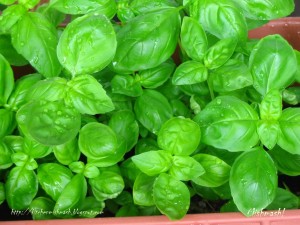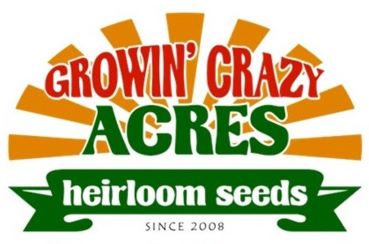Growing Basil
Basil, the common name for Ocimum basilicum, is a popular sweet herb used for flavoring and formerly used for medicinal purposes. An annual of the tropics, it is tender and should not be attempted outdoors until the weather is warm.
Basil grows easily from seed which may be sown in the garden or started indoors. Basil also grows well indoors under fluorescent and HID plant growing lights.
During the long days of summer basil will grow small flowers that are white or purple. Pinch tops regularly to prevent flowering. Can also be pulled and dried before flowering.
 Planting Basil
Planting Basil
Plants should be transplanted or thinned to stand 6 to 10 inches apart; they prefer a quick draining, light soil in a warm location.
If the soil is rich, a plant cut back will develop successive crops of foliage until fall. At that time, roots of strong plants can be lifted and potted up to be moved indoors for a winter supply. Although basil will grow best outdoors, it can be easily grown indoors in a container or hydroponic planter and, like most herbs, will do best on a south-facing windowsill (in the Northern Hemisphere). It should be kept away from any drafts, and must have plenty of sunlight, therefore a greenhouse or cold frame is ideal if available.
Basil plants whose leaves have wilted from lack of water will normally recover if they are watered thoroughly and immediately placed in a sunny location.
Basil can also be propagated very reliably from cuttings.
Leaf production slows or stops on any stem which flowers, so you should pinch off any flower stems to keep the plant in production, or pinch off some stems while leaving others to bloom for decoration or seeds. Once you do let the plant flower, it will produce seed pods containing small black seeds which you can save and plant the following year. Picking the leaves off the plant helps promote continuouse growth, largely because the plant responds by converting pairs of leaflets next to the topmost leaves into new stems.
Growing Cultures
Outdoors, containers (sow direct in final pots, or in plugs and later transplant to final pots), hydroponics. Nighttime temperature must not go below 50 degrees.
Plant Height
Basil usually grows to a height of 12 to 18 inches (30 – 45cm).
Plant Spacing
Basil plants should be spaced between 9 and 12 inches (22 and 30 cm) apart.
Preferred pH Range
Basil will grow in a very wide pH range between 5.1 (strongly acidic) and 8.5 (alkaline) with a preferred range of 5.5 (strongly acidic) to 6.5 (mildly acidic).
Propagation
Sow seed indoors before last frost or direct sow outdoors after last frost. Basil is easily propagated through herbaceous stem cuttings.
Seed Germination Period
5 to 10 days.
Seeds Per Gram (Approximate)
500 – 1000.
Soil Requirements
Well drained, average to rich soil.
Alternative Growing Media
Soilless potting mixes, perlite, vermiculite, rockwool, coco peat, Oasis foam.
Time From Seed to Saleable Plant
Seeds to finished plugs, 8 weeks; plugs to saleable plants, 5 weeks.
Sun & Lighting Requirements
Basil grown outdoors prefers full sun.
Basil will grow indoors satisfactorily under standard fluorescent lamps, and exceptionally well under high output fluorescent , compact fluorescent, or high intensity discharge (metal halide or high pressure sodium) plant growing lights. Keep standard fluorescent lamps between 2 and 4 inches from the tops of the plants, high output and compact fluorescents approximately one foot above the plants, and HID lights between 2 and 4 feet above the plants, depending on wattage. Have an oscillating fan gently stir seedlings for at least 2 hours per day to stimulate shorter, sturdier, and more natural plant habit.
USDA Hardiness
Annual. Not applicable.
Water Requirements
Water on a regular schedule, taking care to not overwater.
Potential Pests & Diseases
Whitefly, thrips, aphids. Fusarium.
Special Notes
Basil is known to attract bees, butterflies or birds and has aromatic foliage.
